Yonggan Fu
Celine
NVIDIA Nemotron Nano 2: An Accurate and Efficient Hybrid Mamba-Transformer Reasoning Model
Aug 21, 2025



Abstract:We introduce Nemotron-Nano-9B-v2, a hybrid Mamba-Transformer language model designed to increase throughput for reasoning workloads while achieving state-of-the-art accuracy compared to similarly-sized models. Nemotron-Nano-9B-v2 builds on the Nemotron-H architecture, in which the majority of the self-attention layers in the common Transformer architecture are replaced with Mamba-2 layers, to achieve improved inference speed when generating the long thinking traces needed for reasoning. We create Nemotron-Nano-9B-v2 by first pre-training a 12-billion-parameter model (Nemotron-Nano-12B-v2-Base) on 20 trillion tokens using an FP8 training recipe. After aligning Nemotron-Nano-12B-v2-Base, we employ the Minitron strategy to compress and distill the model with the goal of enabling inference on up to 128k tokens on a single NVIDIA A10G GPU (22GiB of memory, bfloat16 precision). Compared to existing similarly-sized models (e.g., Qwen3-8B), we show that Nemotron-Nano-9B-v2 achieves on-par or better accuracy on reasoning benchmarks while achieving up to 6x higher inference throughput in reasoning settings like 8k input and 16k output tokens. We are releasing Nemotron-Nano-9B-v2, Nemotron-Nano12B-v2-Base, and Nemotron-Nano-9B-v2-Base checkpoints along with the majority of our pre- and post-training datasets on Hugging Face.
Fewer Denoising Steps or Cheaper Per-Step Inference: Towards Compute-Optimal Diffusion Model Deployment
Aug 08, 2025Abstract:Diffusion models have shown remarkable success across generative tasks, yet their high computational demands challenge deployment on resource-limited platforms. This paper investigates a critical question for compute-optimal diffusion model deployment: Under a post-training setting without fine-tuning, is it more effective to reduce the number of denoising steps or to use a cheaper per-step inference? Intuitively, reducing the number of denoising steps increases the variability of the distributions across steps, making the model more sensitive to compression. In contrast, keeping more denoising steps makes the differences smaller, preserving redundancy, and making post-training compression more feasible. To systematically examine this, we propose PostDiff, a training-free framework for accelerating pre-trained diffusion models by reducing redundancy at both the input level and module level in a post-training manner. At the input level, we propose a mixed-resolution denoising scheme based on the insight that reducing generation resolution in early denoising steps can enhance low-frequency components and improve final generation fidelity. At the module level, we employ a hybrid module caching strategy to reuse computations across denoising steps. Extensive experiments and ablation studies demonstrate that (1) PostDiff can significantly improve the fidelity-efficiency trade-off of state-of-the-art diffusion models, and (2) to boost efficiency while maintaining decent generation fidelity, reducing per-step inference cost is often more effective than reducing the number of denoising steps. Our code is available at https://github.com/GATECH-EIC/PostDiff.
LongMamba: Enhancing Mamba's Long Context Capabilities via Training-Free Receptive Field Enlargement
Apr 22, 2025Abstract:State space models (SSMs) have emerged as an efficient alternative to Transformer models for language modeling, offering linear computational complexity and constant memory usage as context length increases. However, despite their efficiency in handling long contexts, recent studies have shown that SSMs, such as Mamba models, generally underperform compared to Transformers in long-context understanding tasks. To address this significant shortfall and achieve both efficient and accurate long-context understanding, we propose LongMamba, a training-free technique that significantly enhances the long-context capabilities of Mamba models. LongMamba builds on our discovery that the hidden channels in Mamba can be categorized into local and global channels based on their receptive field lengths, with global channels primarily responsible for long-context capability. These global channels can become the key bottleneck as the input context lengthens. Specifically, when input lengths largely exceed the training sequence length, global channels exhibit limitations in adaptively extend their receptive fields, leading to Mamba's poor long-context performance. The key idea of LongMamba is to mitigate the hidden state memory decay in these global channels by preventing the accumulation of unimportant tokens in their memory. This is achieved by first identifying critical tokens in the global channels and then applying token filtering to accumulate only those critical tokens. Through extensive benchmarking across synthetic and real-world long-context scenarios, LongMamba sets a new standard for Mamba's long-context performance, significantly extending its operational range without requiring additional training. Our code is available at https://github.com/GATECH-EIC/LongMamba.
CLIMB: CLustering-based Iterative Data Mixture Bootstrapping for Language Model Pre-training
Apr 17, 2025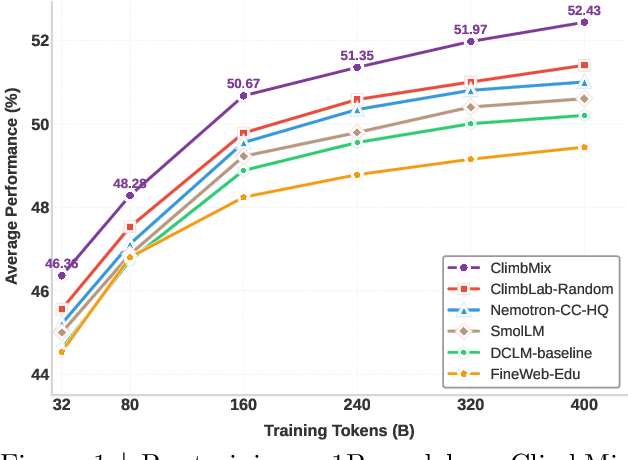

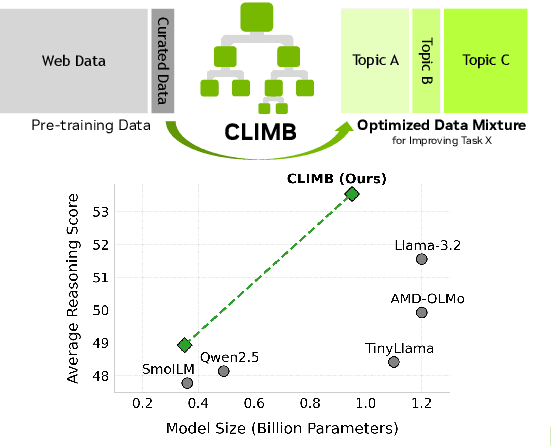
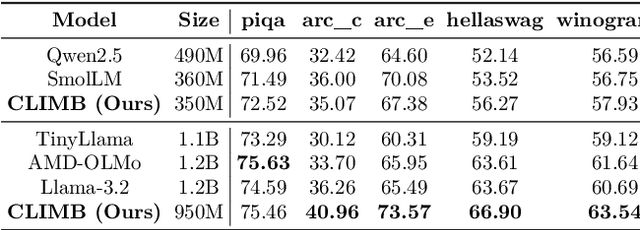
Abstract:Pre-training datasets are typically collected from web content and lack inherent domain divisions. For instance, widely used datasets like Common Crawl do not include explicit domain labels, while manually curating labeled datasets such as The Pile is labor-intensive. Consequently, identifying an optimal pre-training data mixture remains a challenging problem, despite its significant benefits for pre-training performance. To address these challenges, we propose CLustering-based Iterative Data Mixture Bootstrapping (CLIMB), an automated framework that discovers, evaluates, and refines data mixtures in a pre-training setting. Specifically, CLIMB embeds and clusters large-scale datasets in a semantic space and then iteratively searches for optimal mixtures using a smaller proxy model and a predictor. When continuously trained on 400B tokens with this mixture, our 1B model exceeds the state-of-the-art Llama-3.2-1B by 2.0%. Moreover, we observe that optimizing for a specific domain (e.g., Social Sciences) yields a 5% improvement over random sampling. Finally, we introduce ClimbLab, a filtered 1.2-trillion-token corpus with 20 clusters as a research playground, and ClimbMix, a compact yet powerful 400-billion-token dataset designed for efficient pre-training that delivers superior performance under an equal token budget. We analyze the final data mixture, elucidating the characteristics of an optimal data mixture. Our data is available at: https://research.nvidia.com/labs/lpr/climb/
Hymba: A Hybrid-head Architecture for Small Language Models
Nov 20, 2024



Abstract:We propose Hymba, a family of small language models featuring a hybrid-head parallel architecture that integrates transformer attention mechanisms with state space models (SSMs) for enhanced efficiency. Attention heads provide high-resolution recall, while SSM heads enable efficient context summarization. Additionally, we introduce learnable meta tokens that are prepended to prompts, storing critical information and alleviating the "forced-to-attend" burden associated with attention mechanisms. This model is further optimized by incorporating cross-layer key-value (KV) sharing and partial sliding window attention, resulting in a compact cache size. During development, we conducted a controlled study comparing various architectures under identical settings and observed significant advantages of our proposed architecture. Notably, Hymba achieves state-of-the-art results for small LMs: Our Hymba-1.5B-Base model surpasses all sub-2B public models in performance and even outperforms Llama-3.2-3B with 1.32% higher average accuracy, an 11.67x cache size reduction, and 3.49x throughput.
AmoebaLLM: Constructing Any-Shape Large Language Models for Efficient and Instant Deployment
Nov 15, 2024Abstract:Motivated by the transformative capabilities of large language models (LLMs) across various natural language tasks, there has been a growing demand to deploy these models effectively across diverse real-world applications and platforms. However, the challenge of efficiently deploying LLMs has become increasingly pronounced due to the varying application-specific performance requirements and the rapid evolution of computational platforms, which feature diverse resource constraints and deployment flows. These varying requirements necessitate LLMs that can adapt their structures (depth and width) for optimal efficiency across different platforms and application specifications. To address this critical gap, we propose AmoebaLLM, a novel framework designed to enable the instant derivation of LLM subnets of arbitrary shapes, which achieve the accuracy-efficiency frontier and can be extracted immediately after a one-time fine-tuning. In this way, AmoebaLLM significantly facilitates rapid deployment tailored to various platforms and applications. Specifically, AmoebaLLM integrates three innovative components: (1) a knowledge-preserving subnet selection strategy that features a dynamic-programming approach for depth shrinking and an importance-driven method for width shrinking; (2) a shape-aware mixture of LoRAs to mitigate gradient conflicts among subnets during fine-tuning; and (3) an in-place distillation scheme with loss-magnitude balancing as the fine-tuning objective. Extensive experiments validate that AmoebaLLM not only sets new standards in LLM adaptability but also successfully delivers subnets that achieve state-of-the-art trade-offs between accuracy and efficiency.
MG-Verilog: Multi-grained Dataset Towards Enhanced LLM-assisted Verilog Generation
Jul 02, 2024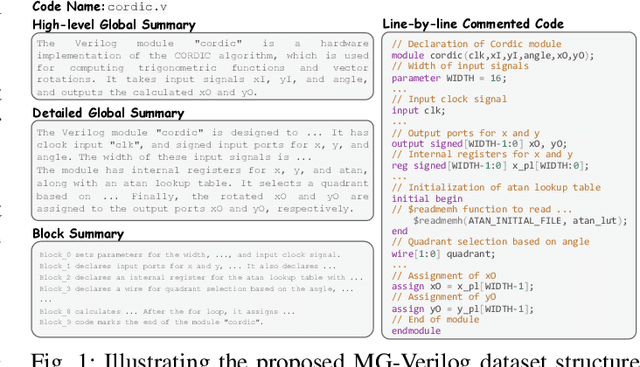
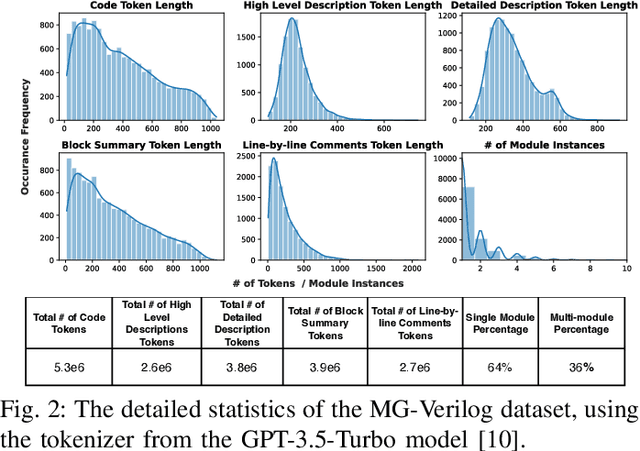
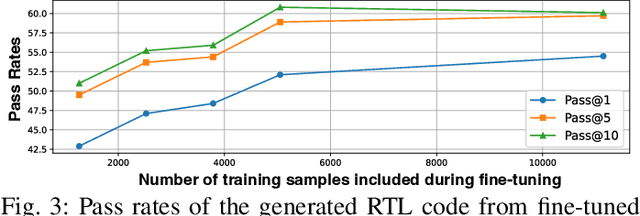
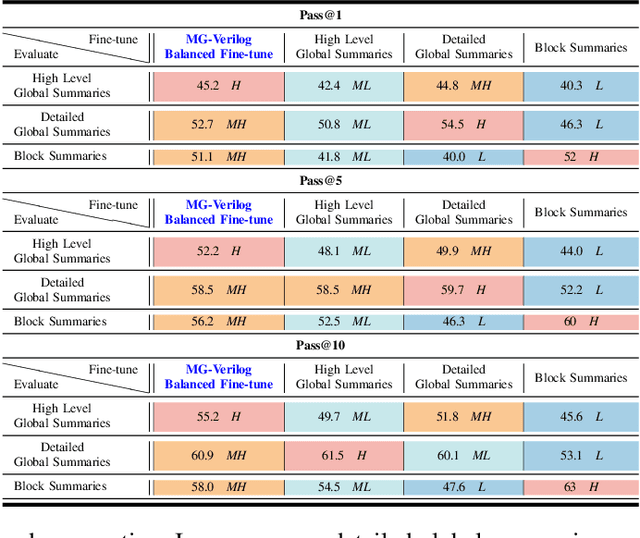
Abstract:Large Language Models (LLMs) have recently shown promise in streamlining hardware design processes by encapsulating vast amounts of domain-specific data. In addition, they allow users to interact with the design processes through natural language instructions, thus making hardware design more accessible to developers. However, effectively leveraging LLMs in hardware design necessitates providing domain-specific data during inference (e.g., through in-context learning), fine-tuning, or pre-training. Unfortunately, existing publicly available hardware datasets are often limited in size, complexity, or detail, which hinders the effectiveness of LLMs in hardware design tasks. To address this issue, we first propose a set of criteria for creating high-quality hardware datasets that can effectively enhance LLM-assisted hardware design. Based on these criteria, we propose a Multi-Grained-Verilog (MG-Verilog) dataset, which encompasses descriptions at various levels of detail and corresponding code samples. To benefit the broader hardware design community, we have developed an open-source infrastructure that facilitates easy access, integration, and extension of the dataset to meet specific project needs. Furthermore, to fully exploit the potential of the MG-Verilog dataset, which varies in complexity and detail, we introduce a balanced fine-tuning scheme. This scheme serves as a unique use case to leverage the diverse levels of detail provided by the dataset. Extensive experiments demonstrate that the proposed dataset and fine-tuning scheme consistently improve the performance of LLMs in hardware design tasks.
Unveiling and Harnessing Hidden Attention Sinks: Enhancing Large Language Models without Training through Attention Calibration
Jun 22, 2024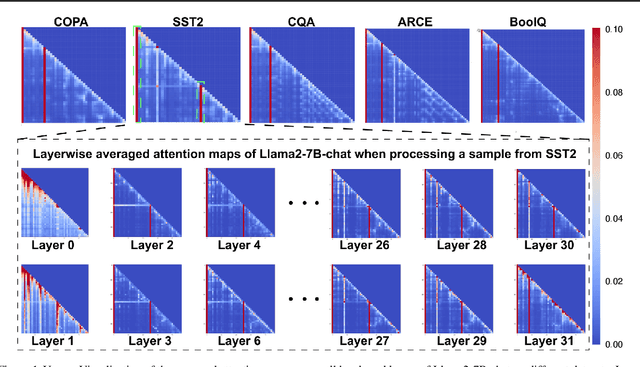
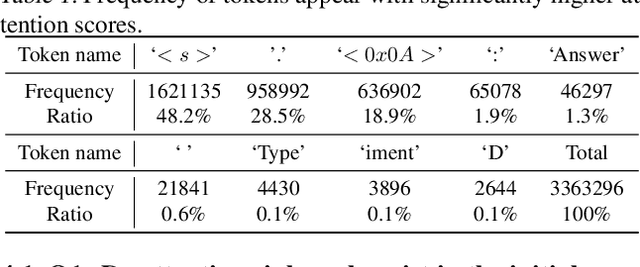
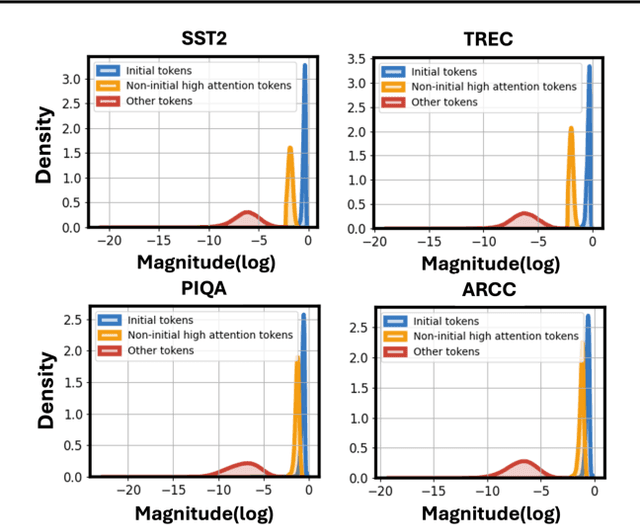
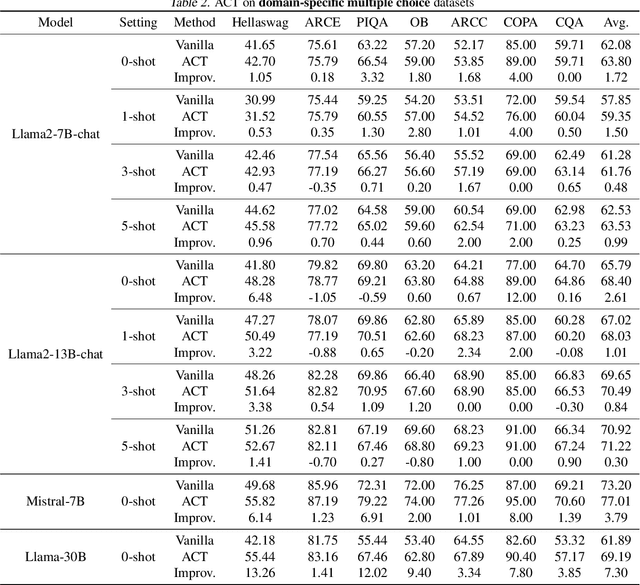
Abstract:Attention is a fundamental component behind the remarkable achievements of large language models (LLMs). However, our current understanding of the attention mechanism, especially regarding how attention distributions are established, remains limited. Inspired by recent studies that explore the presence of attention sink in the initial token, which receives disproportionately large attention scores despite their lack of semantic importance, this work delves deeper into this phenomenon. We aim to provide a more profound understanding of the existence of attention sinks within LLMs and to uncover ways to enhance the achievable accuracy of LLMs by directly optimizing the attention distributions, without the need for weight finetuning. Specifically, this work begins with comprehensive visualizations of the attention distributions in LLMs during inference across various inputs and tasks. Based on these visualizations, to the best of our knowledge, we are the first to discover that (1) attention sinks occur not only at the start of sequences but also within later tokens of the input, and (2) not all attention sinks have a positive impact on the achievable accuracy of LLMs. Building upon our findings, we propose a training-free Attention Calibration Technique (ACT) that automatically optimizes the attention distributions on the fly during inference in an input-adaptive manner. Extensive experiments validate that ACT consistently enhances the accuracy of various LLMs across different applications. Specifically, ACT achieves an average improvement of up to 7.30% in accuracy across different datasets when applied to Llama-30B. Our code is available at https://github.com/GATECH-EIC/ACT.
Omni-Recon: Towards General-Purpose Neural Radiance Fields for Versatile 3D Applications
Mar 17, 2024Abstract:Recent breakthroughs in Neural Radiance Fields (NeRFs) have sparked significant demand for their integration into real-world 3D applications. However, the varied functionalities required by different 3D applications often necessitate diverse NeRF models with various pipelines, leading to tedious NeRF training for each target task and cumbersome trial-and-error experiments. Drawing inspiration from the generalization capability and adaptability of emerging foundation models, our work aims to develop one general-purpose NeRF for handling diverse 3D tasks. We achieve this by proposing a framework called Omni-Recon, which is capable of (1) generalizable 3D reconstruction and zero-shot multitask scene understanding, and (2) adaptability to diverse downstream 3D applications such as real-time rendering and scene editing. Our key insight is that an image-based rendering pipeline, with accurate geometry and appearance estimation, can lift 2D image features into their 3D counterparts, thus extending widely explored 2D tasks to the 3D world in a generalizable manner. Specifically, our Omni-Recon features a general-purpose NeRF model using image-based rendering with two decoupled branches: one complex transformer-based branch that progressively fuses geometry and appearance features for accurate geometry estimation, and one lightweight branch for predicting blending weights of source views. This design achieves state-of-the-art (SOTA) generalizable 3D surface reconstruction quality with blending weights reusable across diverse tasks for zero-shot multitask scene understanding. In addition, it can enable real-time rendering after baking the complex geometry branch into meshes, swift adaptation to achieve SOTA generalizable 3D understanding performance, and seamless integration with 2D diffusion models for text-guided 3D editing.
Towards Cognitive AI Systems: a Survey and Prospective on Neuro-Symbolic AI
Jan 02, 2024Abstract:The remarkable advancements in artificial intelligence (AI), primarily driven by deep neural networks, have significantly impacted various aspects of our lives. However, the current challenges surrounding unsustainable computational trajectories, limited robustness, and a lack of explainability call for the development of next-generation AI systems. Neuro-symbolic AI (NSAI) emerges as a promising paradigm, fusing neural, symbolic, and probabilistic approaches to enhance interpretability, robustness, and trustworthiness while facilitating learning from much less data. Recent NSAI systems have demonstrated great potential in collaborative human-AI scenarios with reasoning and cognitive capabilities. In this paper, we provide a systematic review of recent progress in NSAI and analyze the performance characteristics and computational operators of NSAI models. Furthermore, we discuss the challenges and potential future directions of NSAI from both system and architectural perspectives.
 Add to Chrome
Add to Chrome Add to Firefox
Add to Firefox Add to Edge
Add to Edge